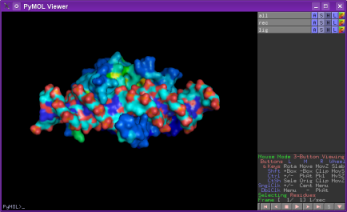

In the current version the plugin covers the following operations: Binding site definition and adjustment, automatic file preparations for receptor definition, straightforward selection of flexible residues, ligand file preparation, generation and viewing of affinity grid maps, viewing of docking poses, and analysis and export of virtual screening results.Ī docking study usually starts with the definition of a binding site, in general a restricted region of the protein. The plugin provides functionality to carry out the entire workflow of a docking study with visual support of PyMOL and a graphical user interface. Hence, an easy to handle Autodock/Vina-plugin for PyMOL is expected to lower the barrier for scientist who are not docking experts to make use of these popular docking protocols within their preferred environment and to use it in conjunction with other applications available for PyMOL. Since PyMOL supports several commonly used file formats for electron density maps it is also the preferred tool for crystallographers. Additionally it provides exceptional 3D-viewing functionalities which can be very useful in structure-based drug design. PyMOL is the most frequently used program for generating publication quality pictures of molecular structures and offers multiple advanced rendering options. The PyMOL plugin described here is developed specifically to make use of PyMOL’s exceptional molecular viewing capabilities. Raccoon and BDT focus on a straightforward data organization important for virtual screening but do not provide molecular viewing functionality whereas DOVIS uses an embedded Java viewer. Raccoon ( ), BDT and DOVIS are other graphical user interfaces for Autodock with a special focus on large-scale virtual screening. The visualizer AutoDockTools offers a complete molecular viewer and a graphical support for all steps required for setup and analysis of docking runs. Since visualization is crucial for structure-based drug design, several tools have been developed to add visual support for the autodock suite. The plugin represents an interface between PyMOL and two popular docking programs, Autodock and Autodock Vina and makes extensive use of a Python script collection (Autodock Tools ) for the setup of docking runs. In the present work we describe a plugin for PyMOL which allows to carry out molecular docking, virtual screening and binding site analysis with PyMOL. CASTp detects pockets and voids in protein structures to determine and characterize binding sites, and eMovie provides a number of functionalities to create animations and movies.

CAVER performs calculations of substrate pathways and entrance tunnels in protein structures which are visualized in PyMOL. The APBS plugin is an interface to the popular adaptive Poisson-Boltzmann solver (APBS ) program and provides easy access to electrostatics calculations and the visualization of potential energy surfaces and charge densities on protein surfaces. In the field of molecular interactions there have been several (plugin)-extensions developed that gain great popularity.

Extensions can either make use of the wizard-interface or the plugin-interface, the latter of which is the more commonly utilized. Through its multi-layer architecture and the use of the powerful object-oriented scripting language Python at the top-level, PyMOL is relatively easy to extend and customize without re-compiling the source code. Over the last years the PyMOL molecular graphics system has evolved from being a powerful molecular viewer with exceptional 3D-capabilities into a platform for several programs and applications which make use of PyMOL’s versatile visualization properties. Visual examination of predicted binding geometries (docking poses) thereby contributes crucially to the further development of a lead compound either towards enhanced binding affinity, towards reduced side effects or towards reduced susceptibility to drug resistance related mutations. If a suitable structure of the target is available molecular docking can be used to discriminate between putative binders and non-binders in large databases of chemicals and to reduce the number of compounds to be subjected to experimental testing substantially. Virtual screening of compound libraries has become a standard technology in modern drug discovery pipelines.


 0 kommentar(er)
0 kommentar(er)
